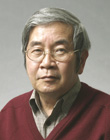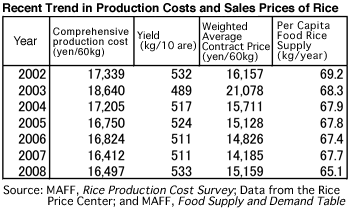Top>Opinion>Will the Income Compensation Program for Rice Farmers Actually Restore Japanese Agriculture? A Discussion about the DPJ Rice Policy
 Index
Index

Shinji Oosu [Profile]
Will the Income Compensation Program for Rice Farmers Actually Restore Japanese Agriculture?
A Discussion about the DPJ Rice Policy
Shinji Oosu
Professor of Agricultural Economics, Faculty of Economics, Chuo University
How did the Individual-Household Income Compensation Model Project for Rice Farmers emerge?
The Food Control Law—which had been the basis of the governmental control system for pricing and distribution of rice for many years—was abolished in 1994, and the new food control law called the Act for Stabilization of Supply-Demand and Prices of Staple Foods provides that the price of rice be subject to market behavior. This caused unstable movement in rice prices, which called for systems to stabilize farmers' incomes.
The Paddy and Upland Business Income Stabilization Program, which was introduced by the Liberal Democratic Party (LDP) administration and implemented starting from the 2007 yield, was very unpopular among farmers. That was because this program only covered certified farmers owning four-hectare or larger fields and community-operated farms with twenty-hectare or larger fields. Among 1.66 million rice farmers, 1.5 million—about ninety percent—only own fields measuring three hectares or less, meaning that almost all farmers were excluded from the program. Their complaint is a matter of course.
In contrast, the Democratic Party of Japan (DPJ) announced their income compensation program in their manifesto for the 2009 general election to differentiate themselves from the LDP. This program covers all merchandising farmers, i.e., farmers who have fields that are thirty-ares or more or who earn annual incomes of 0.5 million yen or more from agricultural sales. As a result of the election, the LDP a suffered landslide defeat ceding control of the administration to the DPJ. Following this change of administration, the DPJ put the greatest emphasis of the agricultural policy on the Individual-Household Income Compensation Model Project for Rice Farmers in the 2010 budget.
The DPJ's manifesto schedule specified that studies and model projects would be conducted in 2010 and the full-scale implementation amounting to one trillion yen would start from 2011. Then-Agricultural Minister Akamatsu announced in October 2009, however, that the model program for rice would be started before programs for other agricultural products and a budget of 561.8 billion yen would be fully secured for it. Thus it was decided to implement the individual-household income compensation model project for rice farmers earlier than initially planned.
Details of the income compensation model project
In the program, the government directly grants farmers a nationally uniform unit value as a subsidy, which is an amount equivalent to the difference between the standard cost for rice production and the sales price of rice. This is intended to enable farmers to finance their rice production through rice sales.
The unit value distributed by the government to farmers consists of fixed and variable portions. The fixed portion is a nationally uniform 15 thousand yen per ten-are field, which was calculated by subtracting the average sales price over the past three years from the standard production cost, which is the average cost of five years selected from the past seven years by excluding the two years with the biggest and smallest costs. If the sales price of harvests for a year is below the average sales price over the past three years, the difference between these prices will be the basis for calculating the variable portion of the distributed unit value for the year (for more information, please see the website of the Ministry of Agriculture, Forestry and Fisheries—MAFF).![]()
The subsidy will be offered to merchandising farmers and community-operated farms that agree to adjust their rice production and cultivate rice according to their production volume targets. Specifically, farmers who are members of mutual aid programs against bad paddy harvests or who have delivered or sold their yields in the previous year are eligible for receiving the subsidy.
The subsidy will be distributed based on the area of fields owned by each farmer, which is calculated by uniformly subtracting ten ares from the area for producing staple-food rice. This ten-are deduction means excluding the area for growing rice for the farmers' own use.
How much annual income will rice farmers earn?

Let us see the movement in the comprehensive production cost (Note 1) over the recent seven years to examine costs for rice production (see the table on the left). The largest was 18,640 yen for the 2008 yield, and the lowest was 16,412 yen for the 2007 yield. With these two years excluded from the seven years in the table, the average cost for the remaining five years is 16,923 yen, which is the theoretical average production cost. This is, however, not the basis for calculating the unit value granted to all merchandising farmers. MAFF defines the standard production cost as eighty percent of operating costs plus family labor costs, instead of the comprehensive production cost itself. The family labor cost is defined as the working hours of the family multiplied by the unit wage that is common between men and women and calculated based on prefectural data on the wages of business entities with five to twenty-nine employees in the construction, manufacturing, and transportation industries, shown in Monthly Labor Survey published by the Ministry of Health, Labor and Welfare. The model project provides, therefore, that the compensation only cover farmers' labor equivalent to eighty percent of wages in small businesses.
For the sales price of the 2008 yield, the weighted average contract price calculated by the Rice Price Center (Note 2) was 15,159 yen per bag (60 kg), and the production volume was 533 kg per ten ares. This results in a distributed subsidy of 1,688 yen per 60 kg. In sum, farmers' income from rice per bag will be 16,847 yen—15,159 yen plus 1,688 yen—which barely meets the total production cost of 16,497 yen.
For the 2007 yield, the rice sales price is 14,185 yen, and the distributed subsidy is 1,762 yen, resulting in farmers' disposable income of 15,947 yen. This is 465 yen short of the comprehensive production cost.
Now let us calculate a rice farmer's income for the 2008 yield assuming the cultivation area of one hectare, which is the average level.
Income from sales: 15,159/60 × 533 × 10 = 1,346,624 yen
The subsidy offered through the compensation program: 15,000 × 10 = 150,000 yen
Summing up the above, we obtain the income from rice of 1,496,624 yen.
The production cost for the above: 16,497 ÷ 60 × 10 × 533 × 10 = 1,465,483 yen
The difference between the two (1,496,624 yen—1,465,483 yen) is 31,141yen.
Adding family labor costs (366,520 yen), interest on farmer's own capital (75,600 yen), and the amount equivalent to rent that the landed farmer would pay in rent (132,290 yen, hereafter cited as landed famer's theoretical rent) to the above, we obtain 605,551 yen, which is the annual income the farmer earns from cultivating a one-hectare paddy. Accordingly, the farmer gains annual income of only about 600 thousand yen from rice even after adding the income compensation.
(Note 1) The comprehensive production cost is the total cost + interest paid + rent paid + interest on farmer's own capital + landed famer's theoretical rent. The interest on farmer's own capital and landed farmer's theoretical rent—both of which are actually not paid—are included because failing to compensate these portions would be a disincentive to economic business expansion.
(Note 2) For the purpose of this calculation, the weighted average annual contract price calculated by the Rice Price Center is regarded as the rice sales price for farmers. This is the average price of various rice brands weighted by their trade volumes.
Declining rice prices and potential surplus due to the abolition of rice production adjustments
Rice prices have recently been declining with surpluses in production. The root cause is that the per capita consumption of rice declined by 4.1kg annually from 2002 to 2008. If this surplus became evident, the price level of rice would fall, leading to a further drop in farmers' income. MAFF, however, abolished the rice production adjustment when the model project started. MAFF holds that the effect of the production adjustment would be achieved as more farmers participate in the model project, because the project only gives eligibility for the subsidy to farmers who produce rice according to the production target. Agricultural cooperatives and rice businesses believe, however, that MAFF is too optimistic. There have always been rice surpluses recently. Without effective measures against excessive rice production, rice prices could plunge at any time.
The governmental rice reserve should also be exploited to address this overproduction. As then-Prime Minister Hatoyama announced at an Upper House Budget Committee session in March, one promising approach would be to move from the rotary method—where rice reserves are sold as staple food after a certain period—to the shelved method—where the reserves are sold for non-staple food use. This announcement, however, has not been realized yet. In short, the government has taken few countermeasures against the oversupply of rice.
Expanded EPA (Economic Partnership Agreement) and FTA (Free Trade Agreement) spur agricultural overproduction
The government is not only neglecting measures against excessive rice production but also promoting policies that will obviously cause further oversupply. The DPJ said in their initial manifesto “we will maintain and expand domestic agricultural production, as well as accelerate negotiations for trade liberalization at the World Trade Organization (WTO) and the conclusion of FTAs with various countries.” In fact, then-Agricultural Minister Akamatsu secured agreement from Korea in March about restart of EPA talks, and agreed with Mexico, Colombia, and other Latin American nations in May about a restart or early conclusion of EPA negotiations. With poor measures against agricultural overproduction implemented, massive inflow of affordable agricultural products from abroad would definitely drive down the prices of agricultural products. Under this situation, the income compensation program alone would not be able to restore agriculture without huge fiscal aid. In addition, the individual-household income compensation program would be ineffective as an agricultural restoration policy if it were not supported with adequate agricultural budgets.
If the trade liberalization were accelerated with anti-oversupply measures insufficiently implemented, there would be a great concern that the individual-household income compensation program might end up being utilized ineffectively.
In order to restore Japanese agriculture and fundamentally improve its rate of agricultural self-sufficiency, the primary challenge must be to secure a sufficient budget.
- Shinji Oosu
Professor of Agricultural Economics, Faculty of Economics, Chuo University - Professor Oosu was born in Kanagawa Prefecture and graduated with an undergraduate degree in Economics from Chuo University in 1965. He left school at the time limit for obtaining credits in the Doctoral Program at the Graduate School of Economics in Chuo University in 1975. He became a full-time lecturer on the Faculty of Economics at Chuo University in 1976 and took up his current position in 1988. Professor Oosu's recent publications include: “Characteristics of the Urban Dairy Crisis and the Possibility of Solving It,” Keizaigaku Ronsan, Chuo University Economics Study Group, 2010.
- Research Activities as a Member of Research Fellowship for Young Scientists (DC1), Japan Society for the Promotion of Science (JSPS) Shuma Tsurumi
- Important Factors for Innovation in Payment Services Nobuhiko Sugiura
- Beyond the Concepts of Fellow Citizens and Foreigners— To Achieve SDGs Goal 10 “Reduce Inequality Within and Among Countries” Rika Lee
- Diary of Struggles in Cambodia Fumie Fukuoka
- How Can We Measure Learning Ability?
—Analysis of a Competency Self-Assessment Questionnaire— Yu Saito / Yoko Neha - The Making of the Movie Kirakira Megane








